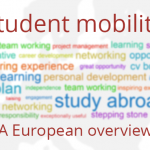Like most industries, the higher education sector has been exploiting information technology in different ways for years. While we have seen a number of interesting changes, such as the increased use of learning management systems and the broader application of computing facilities in many research disciplines, the impact of information technology has still been very limited. Education and research are following their traditional approaches even when using technical tools. The entire community and its institutions are very similar to what they have been for centuries.
But we can see changes arising. There is a new generation of students and academics with entirely new expectations when it comes to the use of ICT. In addition, there are other external factors that boost the change. Financial pressure is one of them: ICT provides cheaper ways to deal with administrative tasks as well as educational activities. Globalization is another factor: modern communications technologies and the availability of high-quality mobile devices allow both teaching and research work to be conducted with fewer dependencies on time and location.
There are already visible signs of change. Some companies and institutions are trying to break the established business models in the higher education industry. For example, there are already a number of institutions offering on-line degrees covering a broad range of subjects. Some high-end institutions set the price tag for their on-line programs at the same level with their on-campus degrees but, increasingly, institutions tend to charge significantly less for an on-line degree compared to its traditional equivalent.
What are the options for an institution to address this change? There are at least three directions to look at:
- Externally visible changes such as on-line degree programs,
- Changes in internal operations to exploit new technology, and
- Changes affecting directly the core of higher education: teaching, learning and research.
External activities
New technology is increasingly visible in the external image of higher education institutions. Typically, the on-line presence of institutions is being extended beyond simple home pages. This may include, for example, student recruitment through social media, offering degree programs with partial or full on-line participation possibilities, and an increased use of on-line tools in creating the student experience.
So far, the most visible external activity has been the creation of Massive Open On-line Courses (MOOCs). They have been around a few years now and they have set a new standard for on-line teaching. We have seen both commercial initiatives and non-profit initiatives, including an increasing number of national approaches, such as the France Université Numérique (FUN). So far, however, higher education institutions have not changed their way of working, and MOOCs seem still to be a digression from their main stream activities. But there are signs that the picture may change especially in the US. Yves Epelboin has been investigating this topic recently in his EUNIS blog.
Business transformation has already started in domains that are close to the higher education business. For example, on-line language learning is increasing rapidly with the proliferation of different approaches ranging from communities of millions of members (e.g. the Livemocha community claims to have over 16 million members) to highly successful individuals that have collected thousands of followers, such as the Français Authentique community (http://www.francaisauthentique.com/). While these examples are not a direct threat to higher education institutions, they offer an interesting preview to the possibilities created by modern technology.
Internal actions
While internal activities are not directly visible to the outside world, they are typically needed to enable changes that will eventually bring in the benefits of the digital era for teaching, learning and research. For example, existing administrative processes can often be automated or turned into self-service activities that users can access through the web. In particular, the use of mobile phones has rapidly increased on all areas of life, and the same will probably take place in universities. This will bring a lot of benefits for both the end users and the service organization.
There is also a need to increase the support for integration. This typically requires an infrastructure that glues IT applications together in the background. While the gluing itself is not visible to the end users, they will benefit from the integration indirectly as the applications will be able to use each other’s data and functionality. Also, integration between IT systems is a prerequisite for advanced automation.
An important area of internal actions is also the development of new capabilities for coping with change. In the past, IT projects took months and years to implement but, today, this is no longer acceptable. As the use of digital tools is directly visible in the daily life of end users, they want to have the IT project results at their disposal as soon as possible, and a delay of weeks or months would be a disaster in many cases. Consequently, the organization must learn to provide quick solutions and this often means changes in the way projects are carried out.
There may also be a need to change the IT organization and the governance model to support more user-focused and agile way of working. In many cases, this means a tighter integration of the IT unit with the rest of the organization. This may be challenging due to the traditional technical background of the IT staff, but it is the only way to reach the required level of co-operation.
Changes in teaching, learning and research
Digital transformation is also directly affecting the core of higher education. Within teaching and learning, some institutions are focusing on blended learning and flipped classrooms whereas others are inclined towards pure on-line learning. In both cases, current learning management tools can already provide a good start but, typically, teachers are not currently exploiting the tools to their full potential. In addition, research and development work is ongoing to create new interesting features, such as the ability of the tools to adapt to the learners’ individual characteristics. The increased use of intelligent tools and learning analytics may lead to a pedagogical transformation.
On the research side, the digital transformation will bring new elements for computationally intensive research work. This will include, among other things, tools for simulation, modeling and data analysis. Such tools have been available for technical research disciplines for years, but their use is being extended towards less technical domains, such as humanities and other similar disciplines. As a result, there will be a need for a much more user-friendly combination of tools and methodologies.
The fact that the world is turning digital has also other consequences for the research work. Research data sets will be a valuable asset in the future competition between research teams. Methodologies and tools will be needed for creating, capturing and reusing data sets. The need for such methodologies is being boosted by the European Union as they require research data to be opened up in Horizon 2020 calls.
Finally, the research process itself will benefit from the use of digital tools for supporting the management, reporting, collaboration and other activities in research projects. For the individual researcher, this will reduce the amount of administrative work and, for the institution, the result is a more accurate way to manage and follow up the research work taking place in different parts of the organization.
It’s time to take action
There is clearly an imperative for change and ignoring it would be a gross mistake. Digital capabilities will be a key success factor in the increasingly competitive higher education landscape, and failure to develop such capabilities will have serious consequences. Some institutions have already drafted separate digital strategies and others have included the use of digital technologies in their institutional strategies, but most of them haven’t made up their minds. It’s time to take action now.
The good thing about the digital future is the fact that we don’t know what it will bring to us. Consequently, the best approach today is to start exploring and experimenting with those elements that are best suited for each institution. As this blog illustrates, there are a lot of options to choose from and, consequently, each institution will have to select its preferred approach for starting the digital transformation.










